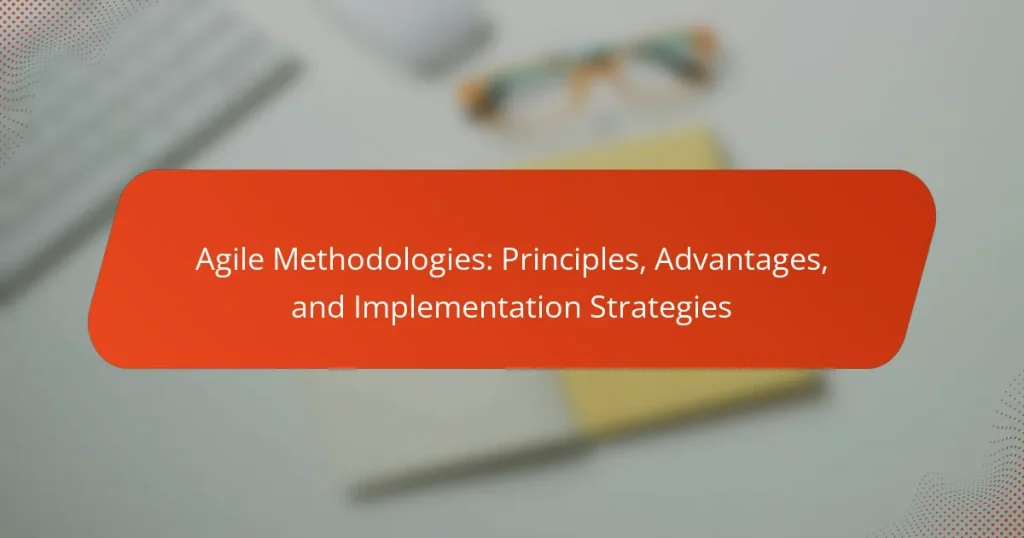Agile methodologies are frameworks that facilitate iterative development and flexibility in project management, emphasizing customer collaboration and responsiveness to change. Key frameworks within Agile include Scrum and Kanban, which focus on delivering small, functional increments of products while encouraging regular stakeholder feedback. Organizations implementing Agile practices often experience increased productivity, improved project visibility, and enhanced customer satisfaction. Successful adoption involves fostering a collaborative culture, training teams on Agile principles, and utilizing structured frameworks to ensure continuous improvement and effective communication.

What are Agile Methodologies?
Agile methodologies are a set of practices that promote iterative development and flexibility in project management. They prioritize customer collaboration over contract negotiation. Agile methodologies emphasize responding to change instead of following a fixed plan. Scrum and Kanban are two popular frameworks within Agile. These methodologies aim to deliver small, functional increments of a product frequently. They encourage regular feedback from stakeholders to enhance the product continuously. Agile methodologies have been shown to improve team productivity and product quality. According to the 2021 State of Agile report, 58% of organizations reported improved project visibility through Agile practices.
How do Agile Methodologies differ from traditional project management?
Agile methodologies differ from traditional project management by emphasizing flexibility and iterative progress. Traditional project management often follows a linear, sequential approach known as the Waterfall model. In Agile, teams work in short cycles called sprints, allowing for regular reassessment and adaptation. This iterative process enables quicker responses to changes in project requirements. Traditional methods typically involve extensive upfront planning and documentation. Agile prioritizes collaboration and customer feedback throughout the project lifecycle. Studies show that Agile can improve project success rates by 28% compared to traditional methods, as reported by the Standish Group in their CHAOS report.
What are the key characteristics of Agile Methodologies?
Agile methodologies are characterized by iterative development, collaboration, and flexibility. They emphasize delivering small, functional increments of software frequently. This approach allows for regular feedback and adjustments based on user needs. Agile methodologies prioritize customer collaboration over contract negotiation. They also encourage teams to self-organize and adapt to changing requirements. Continuous improvement is a core principle, fostering an environment of learning and adaptation. Agile practices include daily stand-ups, sprint reviews, and retrospectives to enhance team communication and efficiency. These characteristics enable teams to respond quickly to market changes and enhance project delivery.
How do Agile principles influence project outcomes?
Agile principles significantly enhance project outcomes by promoting flexibility, collaboration, and customer focus. These principles encourage iterative development, allowing teams to adapt to changes quickly. Frequent feedback loops ensure that the product aligns with customer needs. Additionally, Agile fosters a culture of continuous improvement, which boosts team performance. Studies show that Agile projects have a 28% higher success rate compared to traditional methods. This success is attributed to improved stakeholder engagement and quicker delivery times. Overall, Agile principles lead to more efficient project execution and higher quality results.
What are the core principles of Agile Methodologies?
The core principles of Agile Methodologies are outlined in the Agile Manifesto. These principles prioritize individuals and interactions over processes and tools. Agile emphasizes working software over comprehensive documentation. Customer collaboration is preferred over contract negotiation. Agile values responding to change over following a plan. These principles support flexibility and adaptability in project management. They encourage continuous improvement and iterative progress. Agile fosters a collaborative environment among teams and stakeholders. The principles aim to deliver value to customers efficiently and effectively.
How does the Agile Manifesto guide project teams?
The Agile Manifesto guides project teams by emphasizing four core values and twelve principles. These values prioritize individuals and interactions over processes and tools. They also favor working software over comprehensive documentation. Customer collaboration is preferred over contract negotiation, and responding to change is valued over following a plan.
The twelve principles further clarify these values. They advocate for delivering functional software frequently, welcoming changing requirements, and fostering close collaboration between business stakeholders and developers. Continuous attention to technical excellence and good design is encouraged. Teams are also advised to maintain a sustainable pace of work.
Research shows that teams adhering to the Agile Manifesto report improved flexibility and responsiveness to change. A study published in the Journal of Systems and Software found that Agile practices lead to higher customer satisfaction and better project outcomes. This evidence supports the effectiveness of the Agile Manifesto in guiding project teams.
What are the values emphasized in Agile Methodologies?
Agile Methodologies emphasize four core values. These values are outlined in the Agile Manifesto. The first value is “Individuals and interactions over processes and tools.” This highlights the importance of team collaboration. The second value is “Working software over comprehensive documentation.” This focuses on delivering functional products quickly. The third value is “Customer collaboration over contract negotiation.” This encourages ongoing engagement with clients. The fourth value is “Responding to change over following a plan.” This promotes adaptability in project management. These values guide Agile practices and foster a flexible development environment.

What advantages do Agile Methodologies provide?
Agile methodologies provide increased flexibility and adaptability in project management. They allow teams to respond quickly to changes in requirements. This adaptability leads to improved customer satisfaction. Agile practices emphasize collaboration among team members and stakeholders. Frequent iterations enable continuous feedback and improvement. According to the 2021 State of Agile Report, 58% of organizations reported improved project visibility. Agile methodologies also enhance team productivity by promoting self-organization. Overall, these advantages contribute to more successful project outcomes.
How do Agile Methodologies enhance team collaboration?
Agile methodologies enhance team collaboration by promoting iterative communication and feedback loops. These methodologies encourage regular meetings, such as daily stand-ups, to facilitate open dialogue. This frequent interaction helps team members align their goals and address challenges promptly. Agile practices, like pair programming, foster collaboration by allowing team members to work closely together. Additionally, Agile emphasizes shared ownership of tasks, which strengthens teamwork and accountability. Research shows that teams using Agile report higher satisfaction and productivity levels. A study by the Project Management Institute found that organizations using Agile methodologies improve project success rates by 28%.
What role does communication play in Agile teams?
Communication is essential in Agile teams. It fosters collaboration and enhances team dynamics. Agile methodologies emphasize regular interactions through daily stand-ups and sprint reviews. These meetings ensure transparency and alignment on project goals. Effective communication reduces misunderstandings and accelerates decision-making. According to the Agile Manifesto, “the most efficient and effective method of conveying information is face-to-face conversation.” This principle highlights the importance of direct communication in Agile practices. Studies show that teams with strong communication skills outperform those with poor communication. Thus, communication is a critical factor for success in Agile environments.
How does Agile foster a culture of continuous improvement?
Agile fosters a culture of continuous improvement through iterative processes and regular feedback. Agile teams work in short cycles called sprints. At the end of each sprint, teams hold retrospectives to discuss what went well and what did not. This reflection encourages learning from experiences. Agile emphasizes adaptability, allowing teams to adjust their practices based on feedback. The use of metrics and performance indicators further supports improvement efforts. By prioritizing collaboration, Agile promotes shared ownership of outcomes. This collective responsibility drives teams to seek better solutions continuously. Research shows that organizations using Agile report higher employee engagement and satisfaction, which are critical for fostering improvement.
What are the measurable benefits of implementing Agile?
Implementing Agile methodologies can lead to several measurable benefits. Increased project visibility is one benefit, allowing teams to track progress effectively. Improved collaboration among team members enhances communication and efficiency. Agile also promotes faster delivery of products, with studies showing up to 50% reduction in time-to-market. Higher customer satisfaction results from continuous feedback and iterative improvements. Enhanced adaptability to changes in project requirements is another key advantage, enabling teams to pivot quickly. According to the 14th State of Agile Report, 95% of organizations reported improved project success rates after adopting Agile practices. Overall, these benefits contribute to a more efficient and responsive project management approach.
How does Agile impact project delivery time?
Agile significantly reduces project delivery time. Agile methodologies prioritize iterative development and continuous feedback. This approach allows teams to deliver functional increments of a project more frequently. Research shows that Agile teams can deliver projects 30-50% faster than traditional methods. The emphasis on collaboration and adaptability enables quicker responses to changes. Regular sprint reviews help identify issues early, reducing delays. Agile’s focus on customer feedback ensures that the final product meets user needs efficiently. Overall, Agile’s structured yet flexible framework enhances project delivery timelines effectively.
What cost savings can organizations expect from Agile practices?
Organizations can expect significant cost savings from Agile practices. Agile methodologies reduce project costs by promoting early detection of issues. This leads to lower rework expenses. Agile also enhances team collaboration, which minimizes communication overhead. According to a study by the Standish Group, Agile projects have a 20-30% lower failure rate compared to traditional methods. Additionally, Agile allows for iterative development, enabling teams to prioritize features that deliver the highest value. This focus on value can result in better resource allocation and reduced waste. Overall, the flexibility of Agile practices helps organizations respond to market changes swiftly, further contributing to cost efficiency.

How can organizations effectively implement Agile Methodologies?
Organizations can effectively implement Agile Methodologies by fostering a culture of collaboration and adaptability. They should begin by training teams on Agile principles and practices. Establishing cross-functional teams enhances communication and efficiency. Regularly scheduled meetings, such as daily stand-ups, keep everyone aligned. Utilizing Agile frameworks like Scrum or Kanban can provide structure. Continuous feedback loops help teams improve processes and outcomes. Metrics should be tracked to measure progress and identify areas for improvement. Successful implementation often leads to increased productivity and better project outcomes.
What are the key steps in adopting Agile Methodologies?
The key steps in adopting Agile methodologies include understanding Agile principles, training teams, and initiating pilot projects. First, organizations must familiarize themselves with Agile principles outlined in the Agile Manifesto. This manifesto emphasizes collaboration, flexibility, and customer feedback. Next, comprehensive training for teams is essential to ensure everyone understands Agile practices and roles. This training often includes workshops and certifications. Following training, organizations should initiate pilot projects to test Agile implementation. These projects allow teams to practice Agile in a controlled environment. After the pilot, teams can gather feedback and make necessary adjustments. Finally, scaling Agile practices across the organization is crucial for long-term success. This process often involves continuous improvement and adaptation based on team experiences and outcomes.
How can teams prepare for the transition to Agile?
Teams can prepare for the transition to Agile by adopting key practices and mindsets. First, they should provide Agile training to all team members. This training helps everyone understand Agile principles and methodologies. Second, teams need to establish clear roles and responsibilities. Defined roles enhance accountability and streamline collaboration. Third, teams should adopt iterative planning and feedback loops. Regular iterations allow for continuous improvement and adaptation. Fourth, it is essential to foster a culture of open communication. Transparent communication encourages collaboration and problem-solving. Finally, teams should start small with pilot projects. These pilot projects allow teams to practice Agile in a controlled environment before full implementation. Each of these steps supports a smoother transition to Agile methodologies.
What training or resources are essential for successful Agile adoption?
Essential training for successful Agile adoption includes Scrum Master and Product Owner training. These courses provide foundational knowledge of Agile principles and roles. Agile certification programs, such as those from Scrum Alliance or PMI, enhance understanding and credibility. Workshops on Agile practices help teams implement methodologies effectively. Resources like Agile Manifesto and Scrum Guide offer essential frameworks and guidelines. Additionally, tools like Jira or Trello facilitate Agile project management. According to the State of Agile report, organizations with proper training see a 60% increase in Agile success rates.
What challenges may arise during Agile implementation?
Challenges during Agile implementation include resistance to change, inadequate training, and unclear roles. Resistance often stems from team members accustomed to traditional methodologies. Inadequate training can lead to improper understanding of Agile principles. Unclear roles may cause confusion and hinder collaboration. Additionally, insufficient stakeholder engagement can disrupt progress. Misalignment between teams can lead to communication breakdowns. These challenges can affect overall project success and delivery timelines. Addressing these issues early is crucial for effective Agile adoption.
How can organizations overcome resistance to Agile practices?
Organizations can overcome resistance to Agile practices by fostering a culture of collaboration and openness. They should provide comprehensive training to ensure all team members understand Agile principles. Engaging leadership support is crucial to reinforce the importance of Agile. Regular communication about the benefits of Agile can help mitigate fears and misconceptions. Organizations should also encourage feedback and adapt processes based on team input. Implementing small-scale Agile projects allows teams to experience success gradually. This approach builds confidence and demonstrates the effectiveness of Agile methods. Studies show that organizations with strong leadership support and training see higher adoption rates of Agile practices.
What strategies can be employed to address common pitfalls?
To address common pitfalls in Agile methodologies, teams can implement several strategies. First, they should prioritize clear communication among team members. Regular stand-up meetings can facilitate this by keeping everyone aligned. Second, teams should embrace iterative development. This approach allows for frequent feedback and adjustments. Third, establishing a well-defined product backlog is essential. It helps in managing tasks and priorities effectively. Fourth, teams must ensure stakeholder involvement throughout the process. Engaged stakeholders can provide valuable insights and prevent misalignment. Lastly, conducting regular retrospectives can help identify areas for improvement. This practice encourages continuous learning and adaptation. These strategies collectively enhance the effectiveness of Agile methodologies.
What best practices should be followed for successful Agile implementation?
Successful Agile implementation requires clear communication among team members. Establishing regular stand-up meetings fosters transparency and collaboration. Utilizing iterative development allows for continuous feedback and improvement. Prioritizing tasks based on customer value ensures alignment with business goals. Empowering teams to make decisions enhances ownership and accountability. Adopting a flexible approach to change supports responsiveness to evolving project needs. Continuous training and support for team members lead to sustained Agile practices. These practices are supported by the Agile Manifesto, which emphasizes individuals and interactions over processes and tools.
How can feedback loops improve Agile processes?
Feedback loops enhance Agile processes by fostering continuous improvement. They allow teams to regularly assess their work and make necessary adjustments. This iterative evaluation helps identify issues early in the development cycle. By incorporating feedback, teams can refine their products based on user needs and preferences. Studies show that Agile teams using feedback loops are more responsive to change. For instance, a report by VersionOne indicates that 58% of Agile practitioners believe feedback leads to better project outcomes. Effective feedback loops also promote collaboration among team members, boosting morale and productivity. Overall, they create a culture of learning and adaptation within Agile frameworks.
What tools and technologies support Agile teams effectively?
Agile teams are effectively supported by tools and technologies that enhance collaboration, communication, and project management. Popular tools include Jira, which provides issue tracking and project management features. Trello offers a visual approach to task management with boards and cards. Slack facilitates real-time communication among team members. Additionally, Confluence serves as a collaborative documentation platform. Version control systems like Git enable code management and collaboration. Continuous integration tools such as Jenkins automate testing and deployment processes. These tools collectively streamline Agile workflows and improve team efficiency.
Agile methodologies are iterative development practices that prioritize flexibility, customer collaboration, and responsiveness to change in project management. This article covers the core principles of Agile, highlighting its advantages such as improved project visibility, team productivity, and customer satisfaction. It also contrasts Agile with traditional project management methods, outlines key characteristics and values, and discusses effective implementation strategies. Additionally, the article addresses common challenges and provides best practices for successful Agile adoption, emphasizing the role of communication and feedback loops in enhancing project outcomes.




